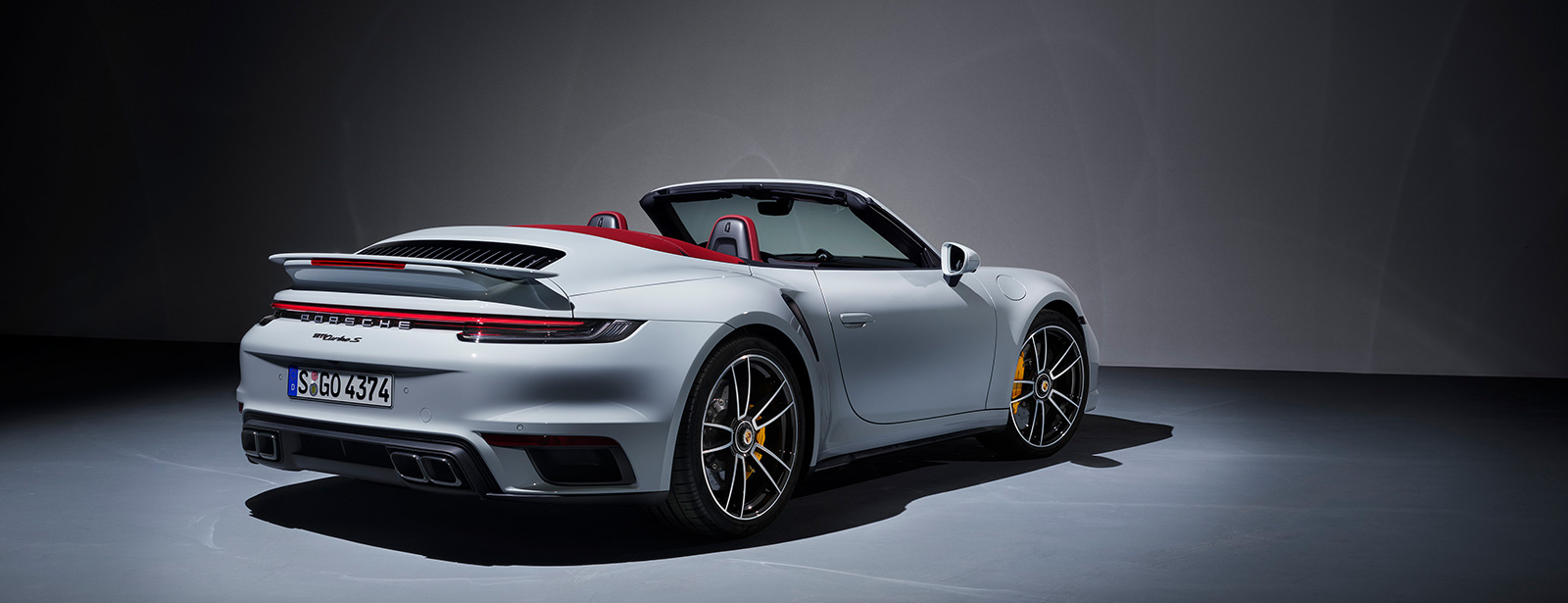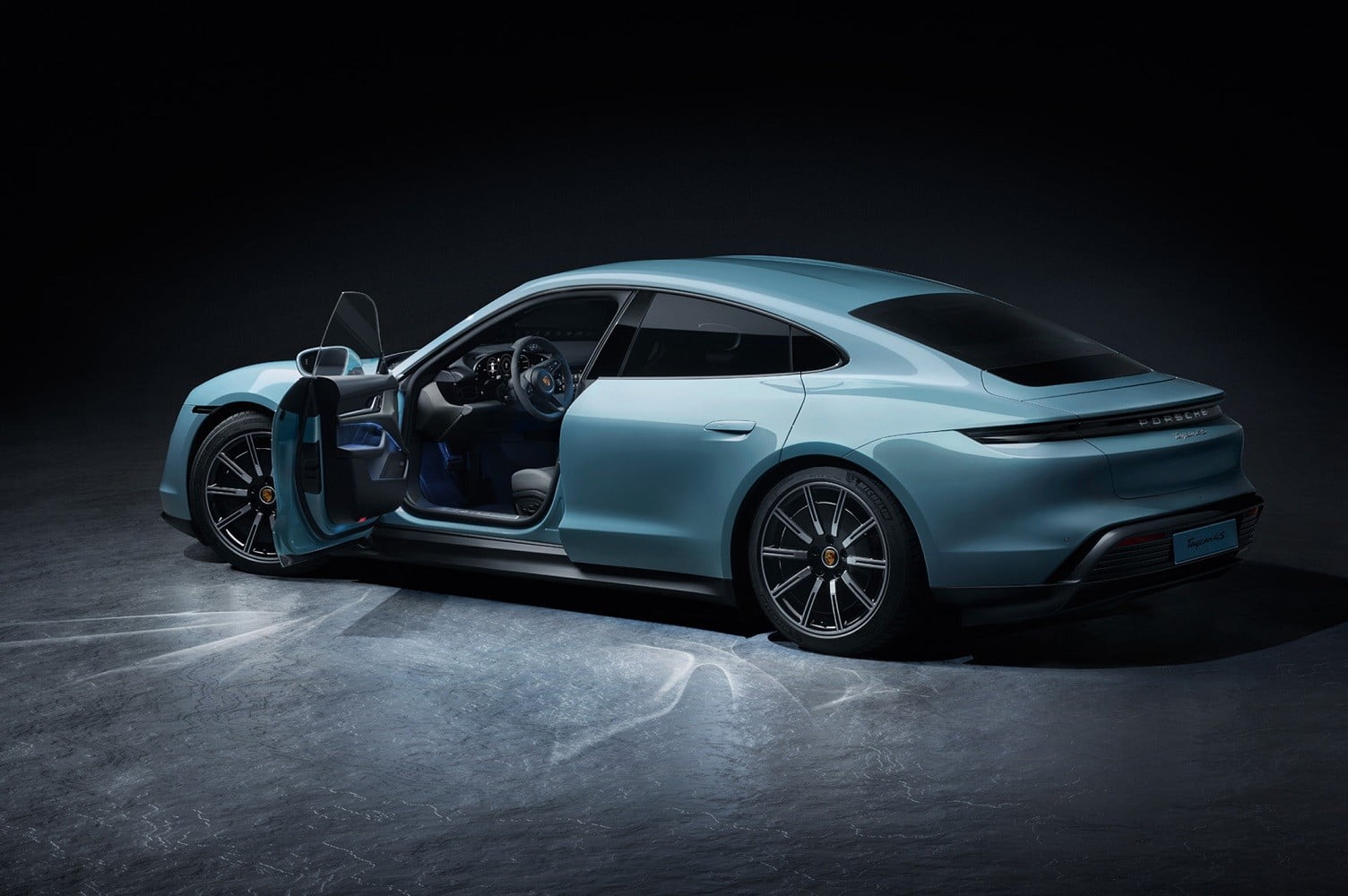Pick A Pair Of Porsches

Driving the 2021 911 Turbo S Cabriolet and the 2021 Taycan
PORSCHE FIRST INTRODUCED THEIR 911 IN 1964, a worthy successor to the 356s which started showing up in America in the early 1950s. It was a radical departure from the more rounded predecessor but it continued the original design of a rear-engine, air-cooled car, jumping from a flat, horizontally opposed, 4-cylinder engine (like its relative, the VW Beetle) to a flat six. However, it wasn’t until 1975 that Porsche joined the turbo world by adding an exhaust-gas compressor (creating more horsepower) to the 911 lineup. Not content to just up the oomph, it also added a rear spoiler—and not just any spoiler—the vaunted “whale tail,” an appendage large enough to host six people for dinner at a tailgate event. The car was a beast with so much boost when the turbo kicked in that drivers had to be careful that they didn’t punch it in a corner.
Flash forward to today. The 2021 911 Turbo S (now a twinturbo) still is the most badass of the Porsche lineup, and the 911 Turbo S Cabriolet is the top of the line, which explains the base price of $219,800. The whale tale is gone, replaced by a more sophisticated and moving spoiler which changes angle depending on the speed. (I’ve often wondered: if your spoiler only deploys at 85 mph, and you’re on the freeway with the spoiler deployed and get pulled over, can you claim the Fifth Amendment against self-incrimination if you own the car?) Anyway, the earlier whale tail 911 had under 250 horsepower; this one has 640 horsepower which can motivate this beauty to 60 mph in about 2.7 seconds (let that sink in for a minute) and can keep thrusting all of the way up to 205 mph (so I am told; I promise that I wasn’t within 10 mph of that number). However, it’s the refined performance which sets this car apart.

Although I’ve often said that Porsches feel to me like they were designed with ergonomics as the key ingredient, the creature comforts abound in this car. That’s not overly surprising, given that the Turbo S Cab is one of the more expensive cars which Porsche produces. The option list on “mine” was fairly restrained, adding only about $18,000 to the price with such items as the upgraded Burmeister Surround Sound System ($3,980) and the Sport Exhaust System ($3,490). Given that the exhaust note on this car is awesome, I was very glad that they popped for that upgrade. Being in Southern California, the Cabriolet is virtually a yearround car, and I made good use of it for the entire week of my loan. Whether in the mountains, by the sea, in the canyons, or on the freeway, it was a delight to drive—docile in traffic and eager, responsive and seriously fast when the crowds were light. Lots of excitement with this car: 0 to 60 in under three seconds will do that to you.
Now let’s shift over to the electric side of the family. Whereas the 911 Turbo S is a fire-breather of the first order, the Taycan is a more subdued vehicle. But let’s not conflate “subdued” with the car being less thrilling or (OMG) slow.
First off, the Taycan now comes in several flavors with two body types. There’s the basic 4-door Taycan model and the four-door Taycan Cross Turismo model which is Porsche’s “shooting brake”/station wagon body style with more interior space. Today, we only are looking at the sedan body style, the “regular” Taycan, and that is available with four motor options.
Let’s see what’s on offer and their base prices:
- Taycan: base of $82,950; 402HP, 0-60 in 5.1 seconds; one rear-axle motor
- Taycan 4S: base of $103,800; 522HP, 0-60 in 3.8 seconds one motor on each axle
- Taycan Turbo: so named but there’s no real “turbo” involved; base of $150,900; 670HP, and 0 to 60 in 3.0 seconds; high-performance motor on each axle
- Taycan Turbo S: base of $185,000; 750HP; 0 to 60 in 2.6 seconds; high-performance motor on each axle
Note: Each model also has a choice of batteries, which affect both the speed and the driving range. The above figures are for the most-powerful battery for that model.
Before we get too distracted by the above power and performance numbers, note that they have asterisks in the real world: those numbers require the driver to utilize “overboost power” and “launch control.” The overboost function adds serious oomph for about 2.5 seconds and gives the car a real kick in the trunk. Launch control is the system which lets the driver floor the accelerator while holding the brakes completely on. The driver then releases the brakes for a truly amazing “hole shot” blast from a standing start. It’s well worth the price of admission!
“My” Tycan was the 4S. Although not the range topper (more on the Turbo S below), it had so many options that the build sheet took three pages to print out. Top options included the $7,170 premium package (panoramic glass roof; BOSE Surround Sound; LED-Matrix design headlights; heated, ventilated, and massage front seats and more); Olea Club leather interior ($6,570); performance battery ($6,580); adaptive cruise control ($3,610); and other optional items which moved the needle from the $103,800 base to $143,630.
Especially with the thermally- and noise-insulated glass ($1,130), the 4S was like driving in a bubble, removed from the normal sounds and heat-gain from the windows. Driving this car was cool and relaxing. Even though it was the second slowest of the Taycan family, the car really did have tremendous acceleration and handling, such that I would recommend the 4S over the base Taycan. My time in the twisty canyons and up on Mulholland also were rewarded as the car goes, stops, and handles very well, all while coddling the driver and the occupants. The fact that it only had a motor on the rear axle was not a negative.
Particularly fun for me was that Porsche also hosted me at the Porsche Experience Center (PEC), of which there are a couple in the United States. The Los Angeles location was very near to my home and a really fun and educational experience, a particular delight as my ride that day was the chart-topping Taycan Turbo S variant.


The PEC is comprised of several tracks meant to show the car’s capabilities, so most of the surfaces were polished concrete with adjacent sprinkler systems to keep the roadway slippery, all set up in order to highlight the exceptional handling of this car. As an extra bonus, it was raining on the day of my PEC experience, so slipping and sliding were easy to achieve.
First off was the skid pad, where I drove around in a tight circle to see how the car behaved with the traction control system off and then on. With the rain adding to the sprinklers’ output, the track was in perfect shape to experience how the car performed in the real world. It was quite amazing. While it took some doing to keep the car pointed in the right direction when the traction control system was off, with the system engaged, it was incredible. It really took effort to lose traction and, with 750 ponies pulling and pushing on your four wheels, it could have been a lot more challenging.
I also experienced the uphill and downhill slippery slopes as well as the emergency braking experience, but my favorite part was experiencing the acceleration area where I was able to repeatedly use the overboost and launch control. This is where a car weighing about 5,100 pounds, in the rain and with sprinklers running, can go from 0 to 60 in 2.6 seconds with virtually no wheel spin. It’s a startling experience, having a car go that quickly on a slippery surface with so little drama, thanks in part to the front and rear motors.
All in all, I had a wonderful time, having two separate weeks with two of the quickest cars on the planet, one with a twin-turbocharged, 6-cylinder, gas-fired engine and the other with a battery-driven electric motor, both able to blast from 0 to 60 in about the same time through very different processes. They both do what they were intended to do and do it very well. Which one is right for you? Well, the good news here is that you can’t make a bad decision.


Sorry, the comment form is closed at this time.